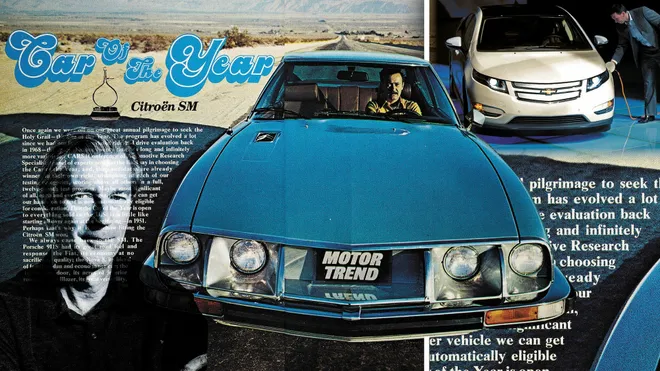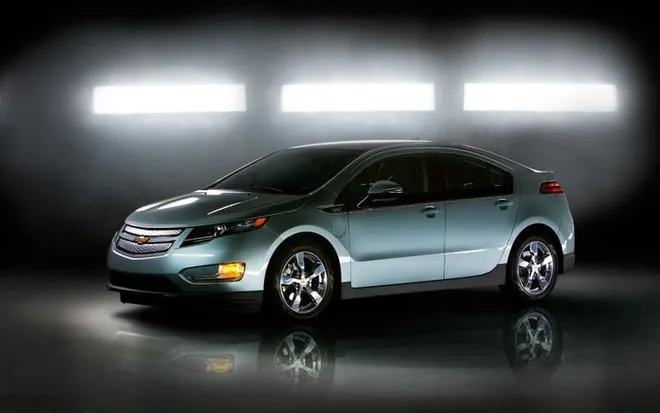Life as MT's editor-in-chief certainly had its moments—including one death threat
The highlights—and one lowlight—of my time as MotorTrend's editorial boss.

The most controversial MotorTrend Car of the Year in the 75-year history of the award? Oh, that’s easy. It was the Chevy Volt, the innovative plug-in hybrid that took home the Golden Calipers trophy in 2011. How do I know this? Well, I’m fairly certain that even in the aftermath of a French car, Citroën’s spaceship SM, being named our 1972 COTY, the editor-in-chief didn’t receive a death threat.
The letter’s long gone now, but the thing I vividly remember—apart from the hair-raising language scrawled across the page—was that the sender had followed good old-fashioned letter-writing protocol and put a return address on the envelope. It turned out to be an empty swampland lot somewhere in Louisiana.

I have a lot of the angry emails that poured in after the Volt announcement, though, stashed away on a backup disc in a folder named The Volt Files. Looking at them 13 years later, I’m struck by … well … let’s just say I’m not surprised QAnon became a thing. At first, I wondered how people could become so enraged over something as quotidian as a Chevy hatchback. But of course, it wasn’t just about a car. It was about politics.
That much was clear when I was invited to be interviewed about the Volt on a Fox News show. After initial pleasantries, the host got straight to the point: How could the Volt be a worthy choice when it was made by a company that had been bailed out by taxpayers (for many, GM’s 2009 bankruptcy was still raw) and sold with the help of taxpayer subsidies?
The Volt won, I replied, because it had excelled against the COTY criteria. (As the world’s automakers begin to backpedal on a wholesale switch to electric vehicles and start investing in plug-in hybrid technology, the Volt looks more and more ahead of its time.) Subsidies, I agreed, were probably a bad thing. But, I asked, if we were going to be upset about subsidies paid to automakers, shouldn’t we also be upset about the $10 billion to $30 billion paid to the American agriculture industry in the form of subsidies every year? The host frowned. “Hmmm. Good point.” The interview ended shortly after.

Looking through The Volt Files served as a reminder of what was perhaps the worst, weirdest moment in my time at the helm of MotorTrend. But it was an outlier; for me, MotorTrend was a place where cool and interesting things happened all the time, and not just in terms of the hundreds of cars and trucks and SUVs I got to drive every year. For instance, not many people in my line of work get to create what was effectively an entire automotive TV channel. Or a TV ad, for that matter.
Making Jaguar’s 30-second “Mark Your Territory” spot, which featured a red XFR-S sedan and lots of smoky drift action before zooming out to show the iconic leaper logo outlined in tire tracks on the tarmac, remains one of the highlights of my career. Not the least because it was created using material largely harvested from a different marketing project our commercial team was working on for the British brand.
I came up with the idea, storyboarded the shoot, and wrote the copy. Our talented video crew shot the extra scenes needed, and the CGI specialists in what was then our special projects operation created the trick shots that gave the ad its eye-catching payoff. Bill Wadsworth, who directed the physical shoot and headed the CGI team, composed and played the backing music. The entire ad was done in-house. Without Jaguar knowing.
We showed the ad at the end of our presentation, after Jaguar had seen all the other work we had been contracted to create. The execs agreed to buy the spot—it was half the price they would have had to pay for a similar ad created by an agency—and it ran on American TV for about two years. They didn’t change a single frame.
The best of times, the worst of times. The Chevy Volt madness apart, my stint as MotorTrend's editor-in-chief of was unquestionably the former.
Disclaimer: The copyright of this article belongs to the original author. Reposting this article is solely for the purpose of information dissemination and does not constitute any investment advice. If there is any infringement, please contact us immediately. We will make corrections or deletions as necessary. Thank you.







